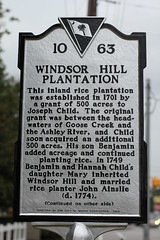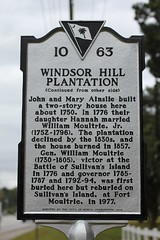 |
 |
|---|
Windsor Hill Plantation featured prominent land rising fifty feet above freshwater swamps at the head of Goose Creek, in the South Carolina coastal plane. Today, the site is slightly more than a mile west of Ashley Phosphate Road, and three miles from the intersection of that road with Interstate Highway 26 in the City of North Charleston.
Wetlands with thick forests once bordered Windsor Hill on three sides. The higher ground rose distinctly above the shallows where planters produced bounties of rice during the colonial era. At that time Windsor Hill Plantation prospered, but most remember the prominence as the burial place of Major General William Moultrie, the famous American patriot. Notwithstanding the importance of that remarkable man, Windsor Hill was the home of other notable colonial and early nineteenth century personalities, who contributed to the development of South Carolina.
Today, the ancient prominence is a locus of homes and businesses convenient to the robust commercial centers of a busy city as it ascends above the hustle of a modern world, overlooks the slow rise of the farthest reaches of the waters of Goose Creek and recalls the spirits of by-gone days.
Heitzler, Michael J. Windsor Hill Plantation, A Crest for Fallen Heroes. Ed. Nancy Paul-Kirchner. 2010. Print.
More pictures from the dedication
The historical marker reads:
This inland rice plantation was established in 17801 by a grant of 500 acres to Joseph Child. The original grant was between the headwaters of Goose Creek and the Ashley River, and Child soon acquired an additional 300 acres. His son Benjamin added acreage and continued planting rice. In 1749 Benjamin and Hanna Child’s daughter Mary inherited rice planter John Ainslie (d. 1774). John and Mary Ainslie built a two-story house here about 1750. In 1776 their daughter Hanna married William Moultrie, Jr. (1752-1796). The plantation was declined by the 1830s, and the house burned in 1857. Gen. William Moultrie (1730-1805), victor at the Battle of Sullivan’s Island in 1776 and governor 1785-1787 and 1792-94, was first buried here but reburied on Sullivan’s Island, at Fort Moultrie, in 1977.
No comments:
Post a Comment